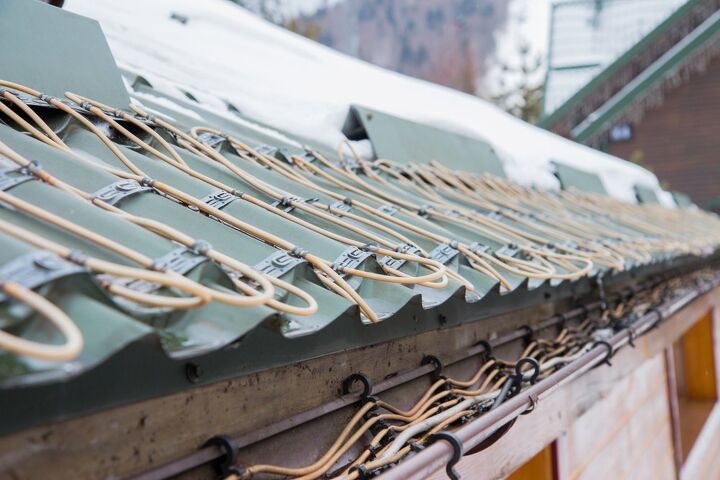How Long Should Roof Heating Cables Be Left On?

Ice dams can wreak havoc on a house and lead to structural problems. Homeowners end up dealing with blistered paint and damage to walls, ceilings, and the roof. If you live in an area prone to ice dams, roof heating cables are one of your best bets to combat these problems. Once installed, these cables can be left on your roof year-round.
Roof heating cables should only be left on during the nighttime, and in the daytime, if the weather is below 40 degrees Fahrenheit, or it’s icy out. It is advised that you do not leave them on for 24 hours a day, but you can if you absolutely need to, especially during storms.
Manually turn on your system a few hours before snow is forecasted to begin and turn off your system once the snow and ice has melted. Snow/ice sensors are also available to turn the system on and off automatically.
Need Roof Heating Cables Installation Services?
Get free, zero-commitment quotes from pro contractors near you.

The Danger of Ice Dams
After a heavy snowstorm, there is a danger of ice dams forming. As the snow begins to melt, it runs off the roof, but refreezes near the edge. As this cycle continues over the winter, a huge bank of ice forms along the roof overhang. Once this forms, melting snow continues to collect behind it.
Over time, the trapped water makes its way beneath the shingles. This can cause leaks and extensive damage to your home.
What is a Heat Cable on a Roof?
One answer to combating ice dams is installing heat cables. De-icing cables are specially designed to be used on the roof and in gutters. They are insulated electric heating wires that are resistant to impact, sunlight, and moisture.
Heat cables are put in place over the eaves and can be put in the gutters as well. The cables pump out heat to keep melted snow from refreezing before it can run down the gutters and into the yard.
Heating cables are installed in a loop pattern, creating arches along the bottom of your roof. The loop height should be 6 to 12 inches longer than your overhang. Loops are spaced 24 inches between peaks and valleys. A clip is placed every one foot along the edge of the roof.
Heat Cables For a Metal Roof
Most roof heating cables sold are designed for asphalt roofs. If you have a metal roof, make sure that the heating cables are meant for a metal roof. Heat cables are attached to a metal roof with special mini clamps that fasten securely to the nail strips on metal roofs. These are different than the clips used on asphalt roofs.
Operation Costs of Heating Cables
A roof de-icing system comes with the initial cost of materials and installation. After this, there are the monthly operating costs. These will show up on your electric bill. A roof that is 120 feet long will use about 290 feet of cable. These cables use about 8W of power per linear foot.
The national average for electricity cost is about 11 cents per kilowatt-hour. If your 290 feet of cable uses 55 kWh per day, this will come to $6.05 per day. If your system runs continuously for 30 days, the cost will be $181.50. This can add up quickly, so it’s best to only use the system when it’s needed.
You can turn the system on and off manually when there is snow or ice on the roof. Another option is to install a snow/ice sensor to turn the system on and off automatically. Maximum temperatures for heating cables range from 150 degrees to 500 degrees Fahrenheit.
The Difference Between Heating Cables and Heating Tape
Heating cables are stiff, whereas heating tape is flexible. Heating tape is sold in fixed lengths and is flexible to fit in tight places or in odd-shaped areas. Heating tape can get hotter and is usually used in smaller areas.
Heat Cable Installation
It is possible to install heating cables, yourself, but hiring a professional is recommended. Proper installation is key to a long life and a solid performance. The cables need to be positioned and fastened correctly. An outdoor GFCI outlet is also needed. If you don’t have one, you will need to hire an electrician to install one.
The system will also need to be designed based on your roof’s size and shape. The solar orientation and wind direction are also factors to consider. You will know the system is designed correctly when working with an experienced professional.
The average cost for materials and installation is between $500 and $600 per 100 feet of cable. You can save yourself some money by purchasing the materials yourself. Most contractors mark-up their supplies. If you can provide the materials and only pay for labor, the price tag will be smaller.
Where to Buy Roof Heating Cables
Roof heating cables can be purchased at most major hardware stores, including Lowe’s, Home Depot, and Menards. They can also be purchased online at sites like Amazon, Northern Tool, Wayfair, and Zoro.
Costs will depend on the length and wattage of the cables. Find lengths from 30 feet to 240 feet and wattage from 150 to 1200. Prices range from about $.60 per linear foot to $1.50 per linear foot. Most kits come with clips and spacers.
Should I Take My Heating Cables Down Each Spring?
It’s certainly possible to take the cables down, but it’s not a good idea. The installation process is quite involved. Heating cables are resilient and held in place by durable clips. Once they are installed, they are meant to stay for years. They do not require regular maintenance.
Roof Heating Cable Repair
Some heating cable systems and installers will offer a warranty. Utilize this for repairs when needed and applicable. Test your system before the first snowfall to make sure it’s working. If not, call a professional to inspect the system and make repairs if necessary.
Keep your installer’s information handy for these instances. The cables will wear out and need to be replaced every 3 to 5 years.
Why Ice Dam Prevention is Best
You may think that you can just get rid of an ice dam after it has formed. However, hacking away at the ice with a chisel or hammer can be dangerous for you and your roof. Using salt will not do much good and harm the plants below your roof. The best way to deal with ice dams is to keep them from happening.
Other Methods to Prevent Ice Dams
Heating cables work well, but there are a few other things you can do to minimize ice dams. These include:
- Adding insulation to the attic floor
- Increasing attic ventilation on the eaves and ridge
- Making sure all exhaust ducts from the kitchen and bathroom vent to the outside, not the attic
- Installing flashing around chimneys
- Sealing any air leaks
Need Roof Heating Cables Installation Services?
Get free, zero-commitment quotes from pro contractors near you.

Related Questions
How long do roof heating cables last?
Roof heating cables generally last between 3 and 5 years. Heating cables that are used more often will wear out faster than those used sparingly.
When should I turn my heating cables on?
If turning your heating cables on and off manually, turn them on when snow is expected. Snow can begin to melt immediately if the cables are turned on an hour or two before it starts to snow.
Are roof heating cables worth it?
The answer to this question is unique to every homeowner. For many, ice dams form because too much warm air is leaking into the attic. Addressing problems like poor insulation or ventilation can prevent ice dams from forming. Raking your roof can also help.However, there are instances where roof heating cables are absolutely needed. If your home has some design flaws and nothing you do keeps ice dams away, they are definitely worth it.

We are a team of passionate homeowners, home improvement pros, and DIY enthusiasts who enjoy sharing home improvement, housekeeping, decorating, and more with other homeowners! Whether you're looking for a step-by-step guide on fixing an appliance or the cost of installing a fence, we've here to help.
More by Upgraded Home Team












![10 Best Zero Turn Mowers – [2022 Reviews & Ultimate Buyer's Guide]](https://cdn-fastly.upgradedhome.com/media/2023/07/31/9070522/10-best-zero-turn-mowers-2022-reviews-ultimate-buyer-s-guide.jpg?size=350x220)














